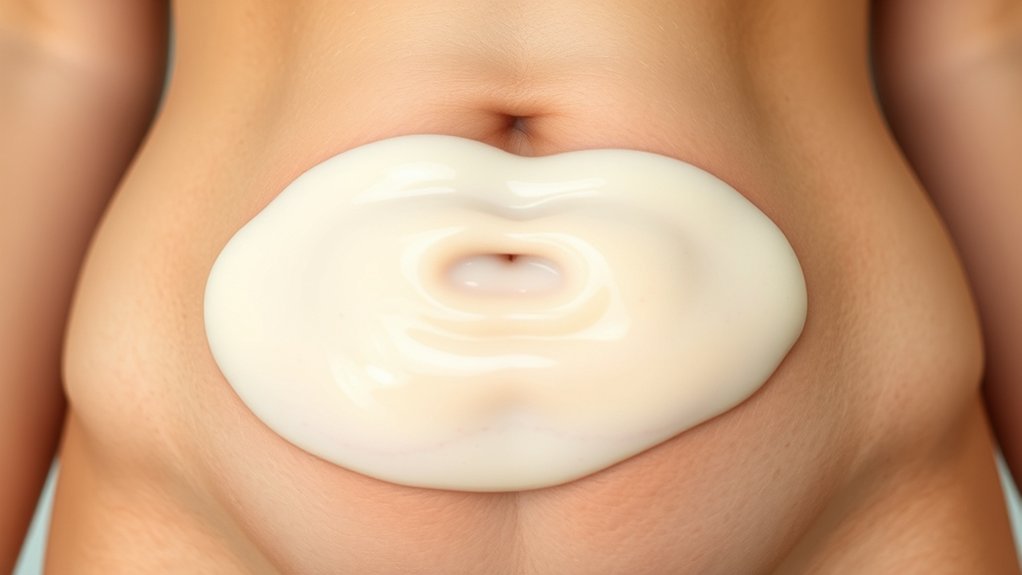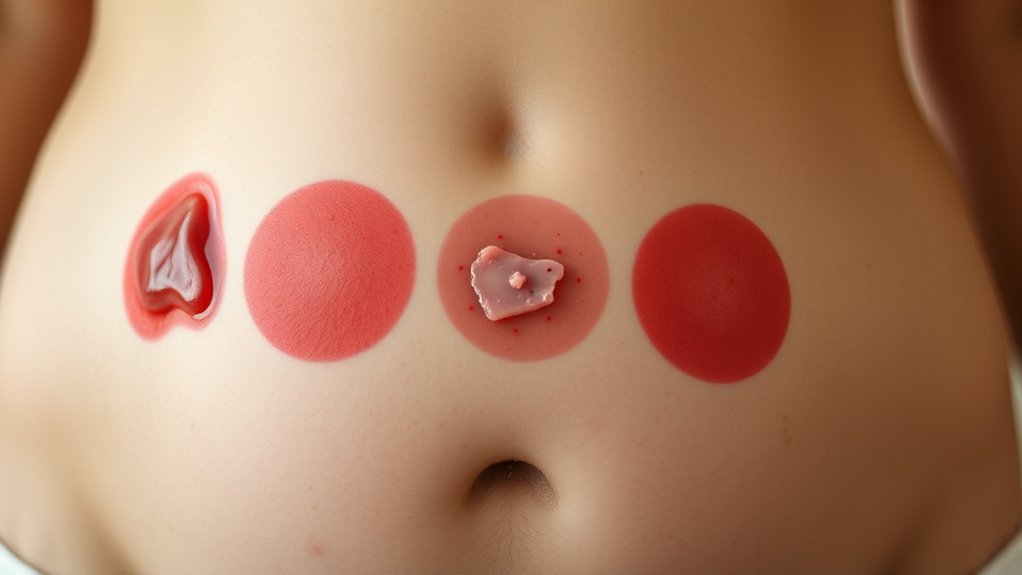Understanding the stages of lochia is vital for postpartum recovery. You’ll notice distinct changes in discharge as your body heals. Lochia Rubra, Lochia Serosa, and Lochia Alba each have specific characteristics and durations. Recognizing these can help you monitor your recovery effectively. However, not all changes are normal. It’s important to know the signs of abnormal lochia and when to seek medical attention. What should you be on the lookout for?
What Is Lochia?
Lochia refers to the vaginal discharge you experience after giving birth, as it plays a crucial role in your body’s healing process.
Lochia is the vital vaginal discharge post-birth, essential for your body’s healing journey.
This discharge consists of blood, mucus, and uterine tissue, helping your uterus return to its pre-pregnancy state.
In the weeks after delivery, you’ll notice changes in the flow and color of lochia, starting with dark or bright red blood, indicative of normal postpartum bleeding.
As your body recovers, this discharge shifts to a pinkish-brown hue and eventually to a creamy, yellowish-white color.
While some blood clots are normal, any foul or fishy odor could signal an infection.
Monitoring lochia is an essential part of postpartum care, providing insight into your recovery during the postpartum period. Additionally, understanding community involvement in maternal health can enhance the support you receive during your healing journey.
The Stages of Lochia
After giving birth, you’ll experience a series of distinct stages in the vaginal discharge known as lochia.
The first stage, Lochia Rubra, typically lasts a few days and features dark or bright red discharge, mild to moderate cramping, and possible small clots.
Next, Lochia Serosa emerges, characterized by pinkish-brown discharge that’s less bloody and thinner, lasting 4 to 12 days with minimal clotting.
Finally, Lochia Alba presents as yellowish or whitish discharge, with little to no blood and a lighter flow, persisting for 2 to 6 weeks.
The duration and characteristics of lochia can vary based on factors like delivery type and uterine health. Understanding these stages helps you recognize normal postpartum bleeding and identify any potential complications, similar to how financial assistance options can provide support in managing healthcare costs postpartum.
Characteristics of Lochia Rubra
The initial stage of postpartum vaginal discharge, known as Lochia Rubra, presents with distinct characteristics that are essential for understanding your recovery. This phase typically lasts for the first few days, featuring dark red bleeding similar to a heavy period. You might notice small clots in the discharge, which is a normal part of postpartum healing.
During Lochia Rubra, you may experience mild to moderate cramping, manageable with pain relief. Be prepared for the possibility of heavy bleeding, soaking a sanitary pad in an hour or less. The table below summarizes these key aspects:
| Characteristic | Description |
|---|---|
| Color | Dark red |
| Clots | Small clots may be present |
| Bleeding | Heavy, similar to a heavy period |
| Duration | First few days |
| Cramping | Mild to moderate |
It’s important to monitor your postpartum recovery closely and consult your healthcare provider if you have concerns about the characteristics of your discharge, especially regarding medication safety during pregnancy.
Characteristics of Lochia Serosa

Lochia Serosa marks a significant shift in your postpartum recovery, characterized by a pinkish-brown discharge that’s thinner and less bloody than Lochia Rubra.
This stage typically lasts from 4 to 12 days, indicating your uterus is healing.
You might notice that the flow is lighter, with occasional small clots, and it may come with mild to moderate cramping. It is important to monitor any changes in your recovery, as early detection of potential complications can significantly influence your overall health.
Color Change Overview
During the second stage of lochia, known as Lochia Serosa, you’ll notice a distinct shift in the color and consistency of the discharge. This stage is characterized by a pinkish-brown hue, indicating it’s less bloody than Lochia Rubra. As your body heals from childbirth, you may experience light bleeding or spotting, with the flow becoming lighter and more intermittent. The color can range from light pink to darker brown, reflecting the ongoing recovery process.
| Stage | Color | Characteristics |
|---|---|---|
| Lochia Serosa | Pinkish-brown | Less bloody, thinner consistency |
| Duration | 4 to 12 days | Decreasing flow, intermittent |
| Healing | Gradual return | Indicates body’s recovery |
Duration and Consistency
In this stage, you can expect Lochia Serosa to last anywhere from 4 to 12 days after childbirth, with an average duration of about 7 to 10 days.
This discharge is characterized by its pinkish-brown color, indicating a shift from the heavier Lochia Rubra. During Lochia Serosa, you’ll notice that the flow is less frequent and lighter, with little to no clotting.
As your body heals, the bleeding slows down, leading to a consistency that becomes more watery and pale. It’s vital to maintain proper postpartum care by changing pads regularly and monitoring the discharge’s color and flow.
This vigilance guarantees a healthy recovery and helps you identify any potential complications.
Characteristics of Lochia Alba

After childbirth, you may notice Lochia Alba, which presents as a yellowish or whitish discharge that typically contains little to no blood.
This stage indicates your body is nearing the end of the postpartum healing process. Lochia Alba usually lasts for about two to six weeks and has distinct characteristics:
- The discharge appears pale yellow or creamy.
- It’s lighter and more watery compared to earlier lochia stages.
- A faint odor may accompany it, but it’s generally not unpleasant.
The presence of Lochia Alba signals that your uterus is returning to its pre-pregnancy state, reflecting normal healing after childbirth. Monitoring these characteristics can help you stay informed about your postpartum recovery. Additionally, it is important to understand the significance of pediatric healthcare services to ensure overall well-being during this period.
Signs of Abnormal Lochia
How can you distinguish between normal and abnormal lochia? It’s essential to recognize signs that may indicate complications. Look out for the following:
| Sign | Description | Action Required |
|---|---|---|
| Large Clots | Clots the size of a golf ball | Medical attention required |
| Excessive Bleeding | Soaking a pad in less than an hour | Contact your healthcare provider |
| Foul-Smelling Discharge | Indicates potential infection | Seek medical evaluation |
Additionally, symptoms such as nausea, chills, or fever-like symptoms can suggest postpartum hemorrhage. If you experience any of these signs, it’s imperative to seek immediate medical attention to safeguard your health and safety. It’s also crucial to monitor your healthcare rights during the postpartum period to ensure you receive the appropriate care.
When to Seek Medical Attention
When should you seek medical attention for lochia concerns?
It’s vital to recognize warning signs during your postpartum experience.
Immediate care is necessary if you notice any of the following symptoms:
- Excessive bleeding that soaks through a pad in less than an hour or lasts for several hours.
- Passing large blood clots, especially those larger than a golf ball.
- A sudden return of heavy bleeding after it had lightened.
Additionally, foul-smelling discharge may indicate an infection, and severe abdominal pain that doesn’t respond to normal pain relief can signal complications. Early intervention is crucial, much like the support for breastfeeding funding that ensures women receive the necessary care during their postpartum period.
Recognizing these symptoms early allows you to receive proper medical care, safeguarding your health during this critical stage.
Frequently Asked Questions
What Are the Red Flags of Lochia?
If lochia’s a river, excessive bleeding, large clots, sudden increases, foul odors, or persistent abdominal pain are the storm clouds. Watch for these red flags; they signal the need for immediate medical attention.
What Does Lochia Feel Like?
Lochia feels like a heavy period initially, shifting to lighter flow with less clotting. You may notice cramping and variations in discharge color and consistency as your body heals and adjusts postpartum.
What Are the Danger Signs of Postpartum Bleeding?
If you’re planning a dramatic reenactment of a horror movie, excessive bleeding, large clots, sudden spikes in flow, foul discharge, or relentless cramps aren’t part of the script. Seek medical help immediately; it’s serious.
What Are the Symptoms of Lochia Infection?
You might experience foul-smelling discharge, excessive bleeding, severe abdominal pain, nausea, or fever if you have a lochia infection. Any of these symptoms require immediate medical attention to guarantee your health and safety.
Conclusion
In summary, understanding the stages of lochia is vital for monitoring postpartum recovery. Approximately 90% of women experience lochia rubra, making it the most common initial discharge. Being aware of the characteristics and duration of each stage helps you recognize normal healing versus potential complications. If you notice any signs of abnormal lochia, such as a sudden increase in bleeding or foul odor, don’t hesitate to seek medical attention to safeguard your health and well-being.
